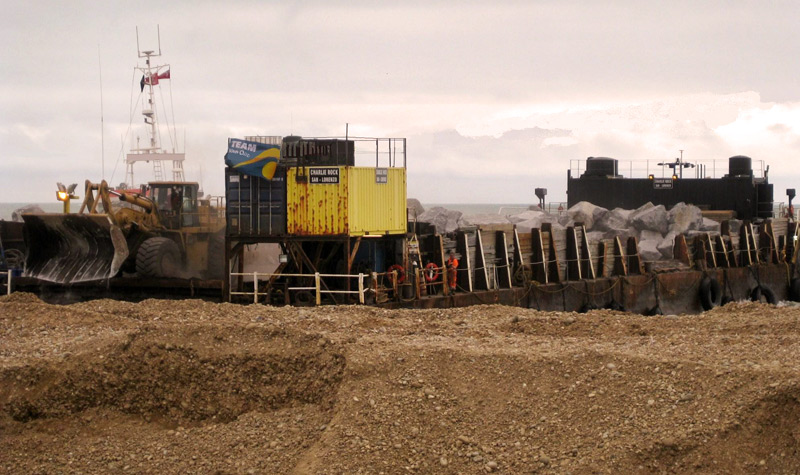Recent visitors to Rye Harbour can’t have failed to notice a large vessel floating, like a Dickensian hulk, about two miles off-shore in Rye Bay. It has been part of the scenery here for about six weeks. It’s destined to become a familiar sight for the next 12 months or so.
What is it doing? Its attendant tug, the Afon Cefni lies attentively by, making occasional journeys to the wharf in Rye Harbour to give its crew a chance to stretch their legs and take on fresh supplies of leeks and lava bread; for you see, the Afon Cefni is from Holyhead. The serene hulk is a shallow draft, sea-going barge, with no motive power of its own and relying on the sturdy tug to move it around Rye Bay or wherever else it may wish to go. For the past six weeks the pair have lived their own solitary existence with the crew of four or five waving at the Harbour Ducks [a familiar term for Rye Harbour folk] as they come into the harbour – and the Harbour Ducks waving courteously back.
The barge is named Charlie Rock – and herein lies a clue to this mysterious vessel. Charlie is used to carry rock armouring to the shore at Broomhill, where the sea defences are being strengthened to prepare the coast for the now famous “one in 200 years event” predicted by the Environment Agency. (If this happens next year can we stop worrying for the next 199 years?)
Rock armouring is placed at the foot of sea defences to take the sting out of the constant thrashing that the tides bring. The sea wall prevents the tides from over-topping the defences and saves the land behind it from flooding. Charlie Rock does look a bit battered and weather worn but if you had spent the past 30 years transporting rocks around the world then no doubt you, too, would have a few scars.
Charlie is waiting for its mother ship, bringing more rocks from Norway, before it can continue its task of building up the defences at Broomhill. The round trip for this other barge, the enormous Stema, takes about five weeks. The rock is commonly called granite but is, in fact, a near relative called Larvikite, coming from the Norwegian port of Larvik. As I write, Stema is making its way south with another 25,000 tonnes of rock, at a very sedate speed of about 5mph, towed by the German tug, Bugsier. It should be here in a few days.
When it arrives, Rye Bay will again become a hive of activity with Charlie being loaded with about 1,500 tonnes of rock at a time and driven on to the shore at Broomhill where the rock will be dumped, ready for the excavators to place it against the sea wall. This will happen at almost every high tide until Stema is empty and returns to Norway for another load. It will take about a year of journeys backwards and forwards to Norway, before the full amount of rock, envisaged to be 260,000 tonnes in total, is in place.
Local residents who are concerned that these deliveries will cause disturbance to their sleep or their leisure time at the weekends may rest assured, for the Environment Agency has undertaken not to work on the scheme above the high-tide line outside of the hours of 8am to 6pm, Monday to Friday and 8am to 1pm on Saturdays. However, the planning authority has granted permission for work to take place below the high-tide line between 6am and 10pm. Planning conditions also allow rock deliveries to take place on to the shoreline 24 hours a day. Any further movement of these rocks will take place during normal working hours. There will be no construction work on Sundays and bank holidays.
After 12 months of this activity I think local residents will be very happy to wave goodbye to the little tug Afon Cefni and her pal, Charlie Rock.

Photos: Philip Moore



